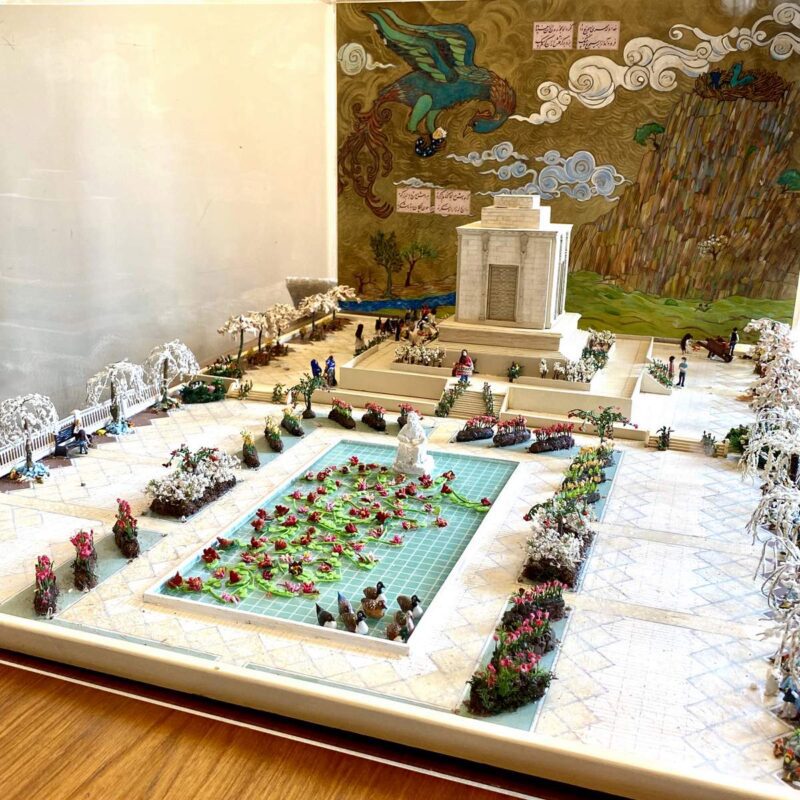
Tomb of Ferdowsi
[ Aramgahe Ferdowsi ]
The first time I visited the Tomb of Ferdowsi, I had no idea that someday I’d be obsessed with the resting place of the poet who single-handedly saved the Persian language.
If I had, I would’ve taken more pictures or maybe tried to contact the mausoleum’s architect, the great Hooshang Seyhoun. It’s too late now; Seyhoun passed away in 2014.
I don’t know why I feel obligated to Ferdowsi. I redid so much of the landscaping to please him. The water lilies floating in the pool was a challenge. Then I replaced 60 clay dahlias with some 100 tiny petunias.
Again, I felt Ferdowsi was not totally happy. So I went through the daunting process of redoing the trees’ colors and forms over and over.
A thousand years ago, dominated by their Arab conquerors, much of what Iranians wrote or spoke was in Arabic. It was Abul-Qâsem Ferdowsi Tusi who saved their language and cultural identity by recounting Iran’s pre-Islamic mythology in a single epic poem known as the Shahnameh or the ‘Book of Kings’. About 55,000 rhyming couplets written over 33 years, twice as long as Homer’s Iliad and Odyssey combined.
His creation went on to become known as the world’s greatest work of Persian poetry. A copy of Shahnameh is found in virtually every Iranian home.
Ferdowsi died penniless and in obscurity in Tus, Iran. But his spirit lives on in the hearts of Farsi speakers all over the world.
Read More
آرامگاه فردوسی
اولین باری که آرامگاه فردوسی را دیدم، هرگز تصور نمیکردم که زمانی در آینده مشتاقانه آرامگاه شاعری را که تک و تنها زبان فارسی را حفظ کرد به صورت یک دیراما بسازم.
اگر چنین فکری را داشتم، عکسهای بیشتری را از آرامگاه میگرفتم و شاید سعی میکردم که با آرشیتکتی که بنای تاریخی فردوسی را ساخته، هوشنگ سیحون، تماس میگرفتم. اکنون دیر شده و سیحون در سال بیست هزارو چهارده فوت کرده.
من نمیدانم چرا به فردوسی احساس وظیفه ودین میکنم. برای راضی نگهداشتن او، تزیین باغ را چندین بار تغییر دادم. ساختن لیلی های آبی در استخر برای من چالش انگیز بود. و بالاخره شصت گل کوکبی را که در باغچه ها کار گذاشته بودم، با صد گل اطلسی ظریف عوض کردم.
برای بار دوم احساس کردم که فردوسی کاملا از کار من خوشحال و راضی نیست. بنابراین با دلهره و ترس شروع به تغییر دادن رنگ و آرایش درختها کردم.
تقریبا هزار سال پیش به علت تسلط اعراب بر ایران بیشتر نوشته ها و گفته های ایرانیان به زبان عربی بود. ابوالقاسم فردوسی توسی زبان فارسی و ارزشهای فرهنگی و هویت ایرانیان را از طریق شناخت اسطوره یا افسانه شناسی در یک کتاب شعر به نام شاهنامه یا کتاب شاهان برگرداند. این کتاب شامل پنجاه وپنج هزار(۵۵،۰۰۰) شعر دو بیتی قافیه دار طی ۳۳ سال، دو برابر کتاب حماسی ایلیاد و ادیسه (یک دیوان شعر حماسی و کهن از یونان باستان) به نگارش درآمده.
خلقت او به عنوان بزرگترین اثر شعر فارسی جهان شناخته شد. نسخه ای از شاهنامه تقریباً در هر خانه ایرانی یافت می شود.
فردوسی بی پول و در گمنامی در طوس ایران درگذشت. اما روح او در دل فارسی زبانان سراسر جهان زنده است.
مطالعه بیشتر














Leave a Reply